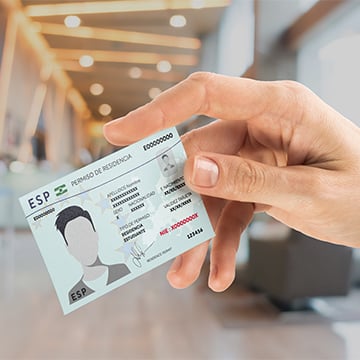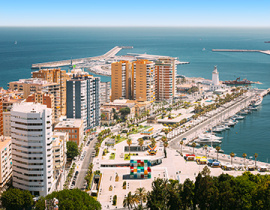- Home
- Blog
- Legislation
- What is TIE in Spain: What It’s Used For and How to Get?
What is TIE in Spain: What It’s Used For and How to Get?
The TIE (Tarjeta de Identidad de Extranjero) is the foreign identity card in Spain. It is used by non-citizens who have been living in Spain for over six months. It can be used to get healthcare, open bank accounts, sign contracts, and prove your identity when dealing with the authorities or private parties.
What is a TIE Card in Spain?
 The TIE is an identification card issued to foreigners who have lived in Spain for more than six months. Getting a TIE in Spain is necessary for access to various services and events in Spain. The TIE includes personal details such as your name, photo, citizenship, and a special identification number.
The TIE is an identification card issued to foreigners who have lived in Spain for more than six months. Getting a TIE in Spain is necessary for access to various services and events in Spain. The TIE includes personal details such as your name, photo, citizenship, and a special identification number.
The TIE is an important document for foreign nationals living in Spain. It serves as a legal residence document, entitles you to access essential services, allows you to make official transactions, and travel within the European Schengen area, also to integrate into Spanish society, and ensures that you comply with immigration laws.
How to Get Your TIE in Spain?
If you are not an European Union/EEA citizen, you will usually need to go through the following steps to get a TIE in Spain:
1/ Apply for a Visa: To apply for a visa, you must first go to the Spanish Consulate or Embassy in your country of residence. The two most popular visas are the Non-Lucrative Visa in Spain and the Visa for Digital Nomads in Spain
2/ Applying for TIE Spain: The TIE must be applied for within 30 days of your arrival in Spain at the Foreigners’ Office, or the nearest police station.
3/ Prepare Documentation: In most cases, the documents needed for TIE in Spain include:
- The application form
- Passport
- Proof of domicile
- Proof of income
- Proof of private health insurance
- Payment of fees
*During the process, fingerprints and photos will be taken.
 4/ Receive Temporary Authorization: After the application is filed, applicants usually receive a TIE (temporary authorization document) while the TIE is being processed.
4/ Receive Temporary Authorization: After the application is filed, applicants usually receive a TIE (temporary authorization document) while the TIE is being processed.
5/ Collect TIE: You’ll be notified to pick up your TIE from your relevant authorities.
It is important to note, however, that the rules and procedures may differ depending on several factors, including your nationality, the purpose of your stay, and current legislation.
Therefore, it is recommended that you seek advice from official sources or consult with a solicitor for specific advice.
Benefits Associated with Holding a TIE
- A TIE gives you access to basic services like health care, education, bank accounts, employment, and social assistance in Spain.
- Official transactions, such as signing contracts, leasing real estate, creating bank accounts, joining up for utilities, and submitting applications for licenses or permits, are made easier by the TIE.
- With a TIE and a valid passport, you can travel in the Schengen area on a visa-free basis for a maximum of 90 days in any 180 days.
- The TIE promotes integration into Spanish society through the recognition of legal status and the right to participate in social, cultural, and community activities.
- Having a TIE can improve your chances of getting a job by showing potential employers that you are legally allowed to work in Spain.
- A TIE provides protection and rights by Spanish law, including the right to legal aid and the right to seek legal advice.
Key Differences Between TIE and Other Identification Documents
The NIE and TIE are two documents that are important for non-Spanish living in Spain. They both serve the same purpose, but they are obtained in different ways. Here are the main distinctions between the two documents:
In terms of Purpose;
The NIE number in Spain is issued by the Spanish tax authorities to non-residents for tax purposes. It can be used to pay taxes, purchase real estate, open bank accounts, or establish businesses in Spain. Even if you are not a Spanish resident but have financial interests in Spain, you may still need an NIE.
On the other hand, the TIE is an identity card that is issued to non-citizens who have been living in Spain for over six months. It is used to prove legal residence and is necessary for access to healthcare, education, work, and social benefits in Spain.
In terms of Documentation;
 To apply for an NIE in Spain, you will usually need to provide the Spanish Police or the Foreigners’ Office with a specific application form, a passport or a national ID, a statement of reasons for applying for an NIE (such as a work contract or property purchase agreement) and pay a fee.
To apply for an NIE in Spain, you will usually need to provide the Spanish Police or the Foreigners’ Office with a specific application form, a passport or a national ID, a statement of reasons for applying for an NIE (such as a work contract or property purchase agreement) and pay a fee.
To apply for a TIE in Spain, you have to go to the Foreigners’ Office or the police station within the first 30 days of your arrival. You will need to submit your TIE application, your passport, proof that you are a legal resident, proof of your financial situation, proof that you have health insurance, and proof that you have paid your fees.
In terms of Form and Content;
An NIE is usually issued as a certificate or a printed document that includes the individual’s NIE number but does not contain personal identification information such as a photo or biometric information.
The TIE is an official identification that contains personal data such as name, photo, citizenship, and a special identification number.
Both the NIE and the TIE are relevant to non-Spanish in Spain, but the NIE is mainly used for tax purposes and administrative purposes, while the TIE is used to prove legal residence and access to services in Spain.
If you're wondering how to get a TIE in Spain, or how to apply for a TIE in Spain, this article has the necessary information. You can also contact the members of our team who will be delighted to guide you toward your Spanish dream! Contact us now for more information.






